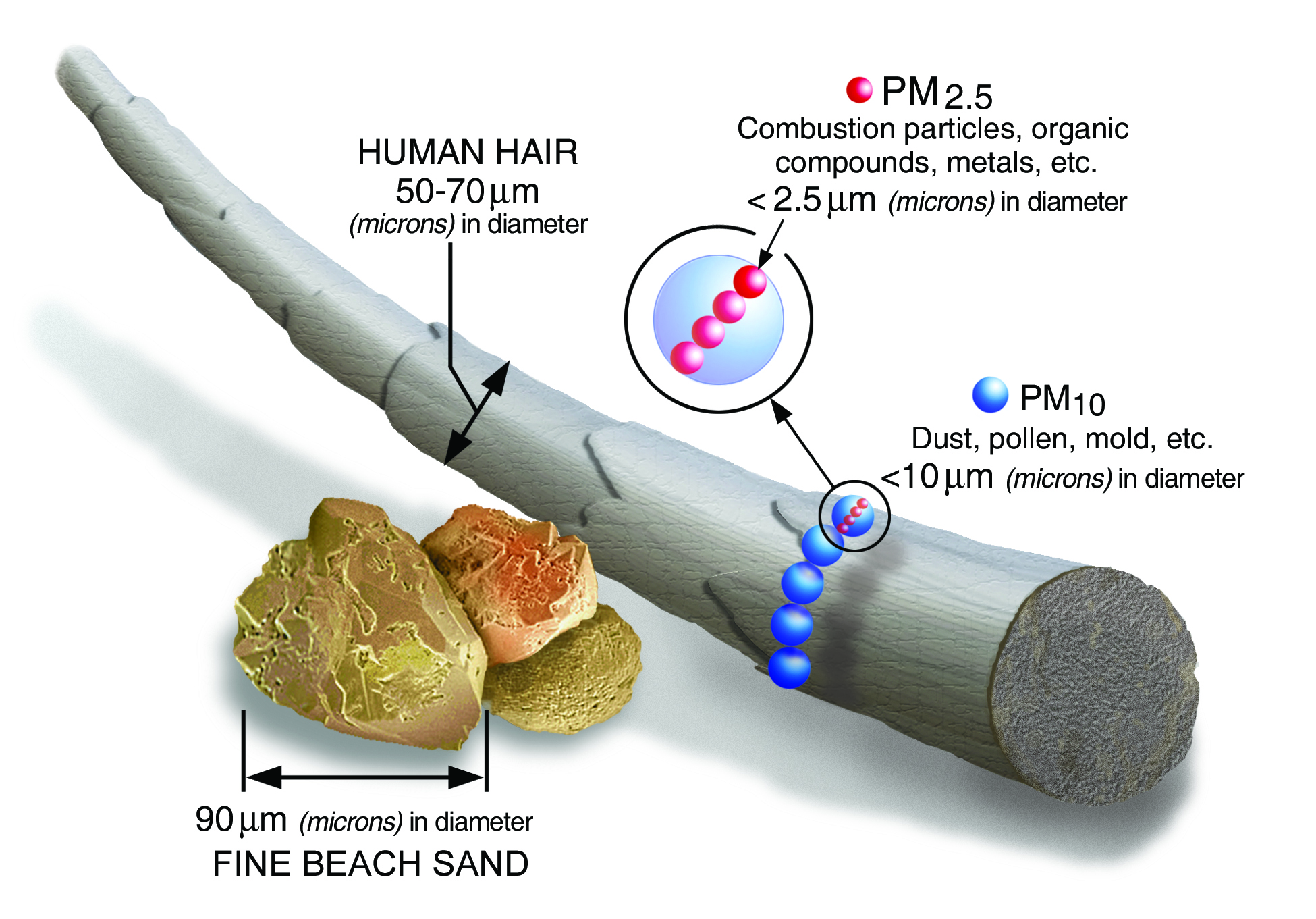The 2018 Global Conference on Air Pollution and Health, organized by the World Health Organization (WHO) 1 and the UN Climate Change secretariat 2, highlighted the urgent need to address air quality. WHO Director-General Tedros Adhanom Ghebreyesus, Ph.D., called air pollution “a silent public health emergency,” a sentiment we strongly support.
In this article, we will examine air quality in the United States, covering pollution sources, environmental and health effects, and monitoring practices. Additionally, we will delve into the specifics of particulate matter (PM), its health risks, and the importance of reducing indoor levels.
What is air pollution?
Air pollution refers to the presence of harmful solid, liquid, or gaseous substances in the air, both indoors and outdoors, at concentrations exceeding recommended or typical levels. The Clean Air Act of 1970, a major U.S. law, identifies six key air pollutants:3
- Particulate matter (PM): Tiny solid and liquid particles suspended in the air. These can originate directly from sources like construction sites, or unpaved roads or be formed through chemical reactions involving pollutants like sulfur dioxides which are emitted from power plants and gas and diesel powered automobiles.
- Ground-level ozone (O3): A gas formed when nitrogen oxides and volatile organic compounds react, often in sunlight. While ozone in the upper atmosphere protects us from UV radiation, ground-level ozone is a harmful pollutant. High levels in the lower atmosphere are harmful because, according to the Environmental Protection Agency (EPA), ozone can trigger a variety of health problems.3
- Carbon monoxide (CO): A colorless, odorless gas produced by incomplete combustion of fuels like gasoline or wood. Poor ventilation can lead to dangerous indoor accumulations.
- Sulfur dioxide (SO2): A pungent, toxic gas released primarily from burning sulfur-containing fuels, often from industrial sources and diesel engines.
- Nitrogen dioxide (NO2): A gas, formed mainly from burning fuels in vehicles, power plants, and other equipment.
- Lead (Pb): A naturally occurring element, also emitted from some industrial processes, that can contaminate air, soil, and water.
Air pollution has significant environmental consequences.
Some key impacts include:
- Acid rain: Pollutants like nitric and sulfuric acids, often released from industrial processes and combustion, can mix with precipitation (rain, fog, snow) or dry particles, creating acid rain. This acidic precipitation damages ecosystems by acidifying water and soil, harming trees, crops, and even buildings.
- Haze: Fine particles in the air, largely from industrial emissions, power plants, and vehicles, reduce atmospheric clarity, creating haze. This reduces visibility and can impact scenic views.
- Climate change: Certain air pollutants contribute to climate change. For example, black carbon, a particulate pollutant from burning fuels, absorbs sunlight and transforms it into heat. This warms the atmosphere and accelerates the melting of glaciers, snow, and sea ice.
Air pollution poses a major threat to human health.
The World Health Organization (WHO) reports that 99% of the global population 4 breathes air exceeding recommended pollution limits, 5 contributing to over 7 million premature deaths annually and impacting the health of billions more. Low- and middle-income countries are disproportionately affected due to higher levels of exposure.
According to WHO data on household air pollution 6 and ambient (outdoor) air pollution, 7 health effects vary by pollutant but generally can include:
- Short-term effects: Irritation of the eyes, nose, skin, and throat, as well as breathing difficulties and headaches.
- Long-term effects: Respiratory infections, stroke, heart disease, lung diseases (including COPD), and immunological disorders.
Longer cumulative exposures are correlated with more severe health outcomes, with some populations being more susceptible. 8 Certain groups are more susceptible, including:
- Infants, children, and teens
- Individuals with lung diseases (especially asthma and COPD)
- People with cardiovascular disease
- People of color
- Current or former smokers
- People with low incomes
- Obese individuals
- Those living in highly polluted areas
Air Quality Measurement:
Understanding what you breathe.
Air quality is measured and reported using a standardized system, although there isn’t a single “good air quality” metric. The U.S. The Environmental Protection Agency (EPA) maintains a database of air quality data from thousands of monitoring stations across the country.8,10 This data is used to calculate the Air Quality Index (AQI), 11 a color-coded system for reporting and forecasting daily air quality.
The EPA sets national air quality standards for six major pollutants (particulate matter, ground-level ozone, carbon monoxide, sulfur dioxide, nitrogen dioxide, and lead). An AQI is calculated for each of these pollutants.
Daily AQI reports are available on websites like AirNow 12 and through state and local environmental agencies. These reports may also be disseminated through local news media or telephone hotlines. 13
The AQI 12 uses a color-coded scale to communicate air quality levels:
Higher AQI values indicate more pollution and greater health concerns. The scale ranges from 0 to 500. Each category includes guidance to help individuals and communities make informed decisions to minimize health risks. For example, while the “Unhealthy for Sensitive Groups” category may not affect most people, someone with asthma might choose to avoid outdoor exercise on such days.
Particulate Matter (PM):
Understanding air’s tiny threat.
Particulate matter (PM), also known as particle pollution, 13 refers to the mixture of tiny solid and liquid particles in the air. These particles are categorized by their diameter in micrometers (µm):
- PM10: Coarse particles, 10 µm or smaller.
- PM2.5: Fine particles, 2.5 µm or smaller.
- PM1.0: Ultrafine particles, 1 µm or smaller.
To give a sense of scale, a grain of fine beach sand is about 90 µm, and a grain of salt is around 60 µm. The human eye can typically see particles between 10 µm and 40 µm (think of dust particulates in a sunbeam). According to ASHRAE, 14 nearly all (99.9%) airborne particles are smaller than PM1.0.
Particulate matter originates from two main sources:
- Direct emissions: Particles released directly from a source, such as dust and debris from construction sites or unpaved roads.
- Indirect formation: Particles formed through chemical reactions between gaseous pollutants, like soot from car exhaust or fireplaces.

Harmful effects of PM: What you need to know.
Exposure to particulate matter (PM) has well-established negative health effects, both short-term and long-term. The EPA notes that inhaling PM can harm the heart and lungs. While any particle smaller than 10 µm can be detrimental, finer particles (PM2.5 and PM1.0) pose a greater risk as they can penetrate deeper into the lungs and even enter the bloodstream. Individuals with heart or lung conditions (like coronary artery disease, congestive heart failure, asthma, or COPD), children, and older adults are particularly vulnerable.
Reducing indoor particulate matter is crucial for protecting human health and well-being.17
Indoor air often contains higher concentrations of PM than outdoor air, and because Americans, on average, spend approximately 90 percent of their time indoors. 18 Exposure to these particles can have a substantial impact on our health.19
Health impacts of PM exposure can include:
- Irritation of the eyes, nose, throat, and lungs
- Worsening of heart and respiratory disease symptoms
- Premature death, especially for those with pre-existing heart or lung conditions
By minimizing indoor PM through strategies like source control, proper ventilation, and effective air cleaning, we can create healthier living and working environments, reducing the risk of these adverse health effects and improving overall quality of life.20
Sources:
- World Health Organization. “Air Pollution.” Accessed February 14, 2025. https://www.who.int/. ↩︎
- United Nations Framework Convention on Climate Change. Accessed February 14, 2025. https://unfccc.int/. ↩︎
- Environmental Protection Agency. “Ground-Level Ozone Pollution: Health Effects of Ozone Pollution.” Accessed February 14, 2025. https://www.epa.gov/ground-level-ozone-pollution/health-effects-ozone-pollution. ↩︎
- World Health Organization. “Air Pollution.” Accessed February 14, 2025. https://www.who.int/health-topics/air-pollution#tab=tab_1. ↩︎
- World Health Organization. WHO global air quality guidelines: particulate matter (PM2.5) and ozone. Geneva: World Health Organization, 2021. Accessed February 14, 2025 https://who.int/publications-detail-redirect/9789240034228. ↩︎
- World Health Organization. “Household Air Pollution and Health.” Fact sheet, May 2, 2022. https://www.who.int/news-room/fact-sheets/detail/household-air-pollution-and-health. ↩︎
- World Health Organization. “Ambient (Outdoor) Air Quality and Health.” Fact sheet, May 2, 2022. https://www.who.int/news-room/fact-sheets/detail/ambient-(outdoor)-air-quality-and-health. ↩︎
- Environmental Protection Agency. accessed February 14, 2025. https://www.epa.gov/. ↩︎
- Environmental Protection Agency. accessed February 14, 2025. https://www.epa.gov/. ↩︎
- Environmental Protection Agency. “Outdoor Air Quality Data.” Accessed February 14, 2025. https://www.epa.gov/outdoor-air-quality-data. ↩︎
- AirNow.gov. “AQI Basics.” Accessed February 14, 2025. https://www.airnow.gov/aqi/aqi-basics/. ↩︎
- American Lung Association. “Air Quality Index.” Accessed February 14, 2025. https://www.lung.org/clean-air/outdoors/air-quality-index. ↩︎
- Environmental Protection Agency. “Indoor Particulate Matter.” Accessed February 14, 2025. https://www.epa.gov/indoor-air-quality-iaq/indoor-particulate-matter. ↩︎
- ASHRAE. accessed February 14, 2025. https://www.ashrae.org/. ↩︎
- Environmental Protection Agency. “PM2.5 Scale.” Image. September 2016. https://www.epa.gov/sites/default/files/2016-09/pm2.5_scale_graphic-color_2.jpg. ↩︎
- Environmental Protection Agency. “Particulate Matter (PM) Basics.” Accessed February 14, 2025. https://www.epa.gov/pm-pollution/particulate-matter-pm-basics. ↩︎
- American Lung Association. “Particulate Matter.” Accessed February 14, 2025. https://www.lung.org/clean-air/indoor-air/indoor-air-pollutants/particulate-matter. ↩︎
- Environmental Protection Agency. “Indoor Air Quality.” Report on the Environment. Accessed February 14, 2025. https://www.epa.gov/report-environment/indoor-air-quality. ↩︎
- Environmental Protection Agency. “Indoor Air Quality (IAQ).” Accessed February 14, 2025. https://www.epa.gov/indoor-air-quality-iaq. ↩︎
- Environmental Protection Agency. “Improving Indoor Air Quality.” Accessed February 14, 2025. https://www.epa.gov/indoor-air-quality-iaq/improving-indoor-air-quality. ↩︎
